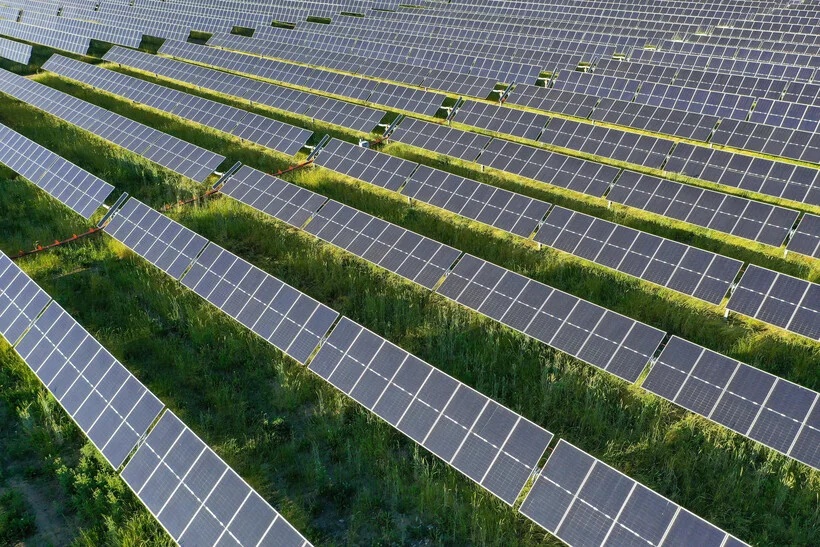Wisconsin Made Progress Toward Clean Energy in 2023
But needs to transition at faster rate to achieve zero carbon emissions by 2050.

The first 150 megawatts of the 300-megawatt Badger Hollow solar farm went online on Dec. 1, 2021. Wisconsin Public Service and Madison Gas and Electric own the project, which was developed by Invenergy. The first phase is expected to power 45,000 homes. Photo courtesy of Wisconsin Public Service/WPR.
Wisconsin continued to make progress in its transition to renewable energy in 2023, but environmental advocates say there’s still a long way to go.
The Public Service Commission of Wisconsin, or PSC, estimates that eight utility-scale solar projects will come online in the state by the end of the year, accounting for 639 megawatts of power. The state’s utility regulator anticipates another three projects will come online in 2024, accounting for 650 megawatts.
According to RENEW Wisconsin, each megawatt of electricity generated via solar powers 190 average Wisconsin homes. That means the solar projects online this year and next will be able to power nearly 245,000 households.
In addition to projects coming online, regulators also approved six future solar projects in 2023, estimated to generate 1,125 megawatts, according to RENEW Wisconsin. Five of those six projects incorporate battery storage systems.
Chelsea Chandler, Climate, Energy & Air program director for Clean Wisconsin, said it’s encouraging to see the state make progress on transitioning away from fossil fuels. But she said more needs to be done to achieve net-zero carbon emissions by 2050.
To hit that goal, she said Wisconsin needs to build 31 gigawatts, or 31,000 megawatts, of solar and 21 gigawatts of wind power. That means the state needs to bring over 1,000 megawatts, or 1 gigawatt, of solar online each year through the middle of the century.
“As far as the approvals for this year go, we’re looking pretty good because we did get over one gigawatt of solar projects approved at the PSC in 2023,” Chandler said. “That’s about double what was approved in 2022.”
Utilities are making progress in bringing facilities online
Alliant Energy anticipates that all 12 of its solar projects that have been approved by the PSC — totaling 1,089 megawatts — will be completed by mid-2024. Officials say those 12 sites, when online, will produce enough electricity to power nearly 300,000 homes.
Last year, the utility completed three projects totaling 250 megawatts, and will double that by the end of this month, said David de Leon, Alliant Energy’s Wisconsin president.
In addition, Alliant has plans for three major battery projects in Wisconsin, providing over 1,000 megawatt-hours of storage, de Leon said. Those projects can store solar power for times when the sun is not shining.
“As we are going to be retiring our older fossil fuel facilities and adding those additional renewable resources to our generation portfolio, those energy storage solutions are key to being able to be a good complement to delivering energy to our customers,” he said.
Other utilities also made progress this year. Xcel Energy surpassed the milestone of producing over half of its electricity company-wide without carbon.
“We are already at 69 percent carbon-free in Wisconsin and across the Upper Midwest, and we are on track to meet or even exceed 80 percent carbon-free by the end of this decade,” said Xcel spokesperson Chris Ouellette.
Additionally, the Red Barn Wind Park came online in Grant County this year, a 92 megawatt joint venture between Wisconsin Public Service, or WPS, and Madison Gas & Electric.
WPS also expects to “substantially complete” the second phase of the Badger Hollow Solar Park project this year, with some final work possibly early next year. That project is another partnership with Madison Gas & Electric that will produce 300 Megawatts when both phases are fully operational.
WEC Energy Group, the owner of WPS and We Energies, also hopes to complete the 250 megawatt Darien Solar Energy Center next year. The solar portion of the Paris Solar-Battery Park project is estimated to go into service in 2024, and the battery portion in 2025.
Environmental advocate says now is the time to transition away from fossil fuels
Chandler, with Clean Wisconsin, also pointed to a pair of developer-led projects that have yet to reach the PSC as others that could play a major role in achieving net-zero emissions.
Those are the Vista Sands Solar Farm, a 1,200 megawatt project in Portage County, and Uplands Wind, a 600-megawatt wind energy project in Lafayette and Iowa Counties.
“Some developers choose to develop a project and then sell it to a utility, others will own and operate,” she said. “With all of Wisconsin’s investor-owned utilities having carbon-neutral goals by mid-century … I wouldn’t anticipate any problem in finding a market for that electricity.”
Chandler also said the longer the transition away from fossil fuels is delayed, the worse the effects of climate change will be. She added that climate change is no longer a “far off problem.” Its effects are already being felt — even in Wisconsin.
“An example from this summer (is) the terrible air quality that we had because of the wildfire smoke from the Canadian wildfires,” Chandler said. “Air pollution does not respect state or international borders, and the fires from Canada absolutely impacted us here.”
Wisconsin made progress toward clean energy transition in 2023, but more work is needed was originally published by Wisconsin Public Radio.





















